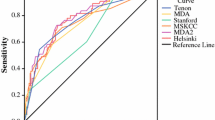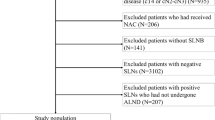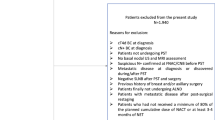Abstract
Recently, many centers have omitted routine axillary lymph node dissection (ALND) after metastatic sentinel node biopsy in breast cancer due to a growing body of literature. However, existing guidelines of adjuvant treatment planning are strongly based on axillary nodal stage. In this study, we aim to develop a novel international multicenter predictive tool to estimate a patient-specific risk of having four or more tumor-positive axillary lymph nodes (ALN) in patients with macrometastatic sentinel node(s) (SN). A series of 675 patients with macrometastatic SN and completion ALND from five European centers were analyzed by logistic regression analysis. A multivariate predictive model was created and validated internally by 367 additional patients and then externally by 760 additional patients from eight different centers. All statistical tests were two-sided. Prevalence of four or more tumor-positive ALN in each center’s series (P = 0.010), number of metastatic SNs (P < 0.0001), number of negative SNs (P = 0.003), histological size of the primary tumor (P = 0.020), and extra-capsular extension of SN metastasis (P < 0.0001) were included in the predictive model. The model’s area under the receiver operating characteristics curve was 0.766 in the internal validation and 0.774 in external validation. Our novel international multicenter-based predictive tool reliably estimates the risk of four or more axillary metastases after identifying macrometastatic SN(s) in breast cancer. Our tool performs well in internal and external validation, but needs to be further validated in each center before application to clinical use.


Similar content being viewed by others
References
Truong PT, Vinh-Hung V, Cserni G, Woodward WA, Tai P, Vlastos G, Group MotINRW (2008) The number of positive nodes and the ratio of positive to excised nodes are significant predictors of survival in women with micrometastatic node-positive breast cancer. Eur J Cancer 44(12):1670–1677
Vinh-Hung V, Verkooijen HM, Fioretta G, Neyroud-Caspar I, Rapiti E, Vlastos G, Deglise C, Usel M, Lutz JM, Bouchardy C (2009) Lymph node ratio as an alternative to pN staging in node-positive breast cancer. J Clin Oncol 27(7):1062–1068
Kim T, Giuliano AE, Lyman GH (2006) Lymphatic mapping and sentinel lymph node biopsy in early-stage breast carcinoma: a metaanalysis. Cancer 106(1):4–16
Gärtner R, Jensen MB, Nielsen J, Ewertz M, Kroman N, Kehlet H (2009) Prevalence of and factors associated with persistent pain following breast cancer surgery. JAMA 302(18):1985–1992
Giuliano AE, McCall L, Beitsch P, Whitworth PW, Blumencranz P, Leitch AM, Saha S, Hunt KK, Morrow M, Ballman K (2010) Locoregional recurrence after sentinel lymph node dissection with or without axillary dissection in patients with sentinel lymph node metastases: the American College of Surgeons Oncology Group Z0011 randomized trial. Ann Surg 252(3):426–432 discussion 432–433
Giuliano AE, Hunt KK, Ballman KV, Beitsch PD, Whitworth PW, Blumencranz PW, Leitch AM, Saha S, McCall LM, Morrow M (2011) Axillary dissection vs. no axillary dissection in women with invasive breast cancer and sentinel node metastasis: a randomized clinical trial. JAMA 305(6):569–575
Wasif N, Ye X, Giuliano AE (2009) Survey of ASCO members on management of sentinel node micrometastases in breast cancer: variation in treatment recommendations according to specialty. Ann Surg Oncol 16(9):2442–2449
Bilimoria K, Bentrem D, Hansen N, Bethke K, Rademaker A, Ko C, Winchester D, Winchester D (2009) Comparison of sentinel lymph node biopsy alone and completion axillary lymph node dissection for node-positive breast cancer. J Clin Oncol 27(18):2946–2953
Pepels MJ, Vestjens JH, de Boer M, Smidt M, van Diest PJ, Borm GF, Tjan-Heijnen VC (2011) Safety of avoiding routine use of axillary dissection in early stage breast cancer: a systematic review. Breast Cancer Res Treat 125(2):301–313
Recht A, Edge SB, Solin LJ, Robinson DS, Estabrook A, Fine RE, Fleming GF, Formenti S, Hudis C, Kirshner JJ et al (2001) Postmastectomy radiotherapy: clinical practice guidelines of the American Society of Clinical Oncology. J Clin Oncol 19(5):1539–1569
Aebi S, Davidson T, Gruber G, Cardoso F, Group EGW (2011) Primary breast cancer: ESMO clinical practice guidelines for diagnosis, treatment and follow-up. Ann Oncol 22(Suppl 6):vi12–vi24
Chagpar AB, Scoggins CR, Martin RC, Cook EF, McCurry T, Mizuguchi N, Paris KJ, Carlson DJ, Laidley AL, El-Eid SE et al (2007) Predicting patients at low probability of requiring postmastectomy radiation therapy. Ann Surg Oncol 14(2):670–677
Rivers AK, Griffith KA, Hunt KK, Degnim AC, Sabel MS, Diehl KM, Cimmino VM, Chang AE, Lucas PC, Newman LA (2006) Clinicopathologic features associated with having four or more metastatic axillary nodes in breast cancer patients with a positive sentinel lymph node. Ann Surg Oncol 13(1):36–44
Katz A, Smith BL, Golshan M, Niemierko A, Kobayashi W, Raad RA, Kelada A, Rizk L, Wong JS, Bellon JR et al (2008) Nomogram for the prediction of having four or more involved nodes for sentinel lymph node-positive breast cancer. J Clin Oncol 26(13):2093–2098
Leidenius M, Vaalavirta L, Heikkilä P, von Smitten K, Salmenkivi K (2008) The prevalence of and risk factors for four or more metastatic axillary lymph nodes in breast cancer patients undergoing sentinel node biopsy. J Surg Oncol 98(1):21–26
Cserni G, Boross G, Maráz R, Leidenius MH, Meretoja TJ, Heikkila PS, Regitnig P, Luschin-Ebengreuth G, Zgajnar J, Perhavec A et al (2012) Multicentre validation of different predictive tools of non-sentinel lymph node involvement in breast cancer. Surg Oncol 21(2):59–65
Cserni G, Bori R, Maráz R, Leidenius MH, Meretoja TJ, Heikkila PS, Regitnig P, Luschin-Ebengreuth G, Zgajnar J, Perhavec A et al (2012) Multi-institutional comparison of non-sentinel lymph node predictive tools in breast cancer patients with high predicted risk of further axillary metastasis. Pathol Oncol Res. doi:10.1007/s12253-012-9553-5
Sobin LH, Wittekind Ch (eds) (2002) TNM classification of malignant tumours. Wiley-Liss, New York
Van Zee KJ, Manasseh DM, Bevilacqua JL, Boolbol SK, Fey JV, Tan LK, Borgen PI, Cody HS, Kattan MW (2003) A nomogram for predicting the likelihood of additional nodal metastases in breast cancer patients with a positive sentinel node biopsy. Ann Surg Oncol 10(10):1140–1151
Hwang RF, Krishnamurthy S, Hunt KK, Mirza N, Ames FC, Feig B, Kuerer HM, Singletary SE, Babiera G, Meric F et al (2003) Clinicopathologic factors predicting involvement of nonsentinel axillary nodes in women with breast cancer. Ann Surg Oncol 10(3):248–254
Farshid G, Pradhan M, Kollias J, Gill PG (2004) A decision aid for predicting non-sentinel node involvement in women with breast cancer and at least one positive sentinel node. Breast 13(6):494–501
Saidi RF, Dudrick PS, Remine SG, Mittal VK (2004) Nonsentinel lymph node status after positive sentinel lymph node biopsy in early breast cancer. Am Surg 70(2):101–105 discussion 105
Barranger E, Coutant C, Flahault A, Delpech Y, Darai E, Uzan S (2005) An axilla scoring system to predict non-sentinel lymph node status in breast cancer patients with sentinel lymph node involvement. Breast Cancer Res Treat 91(2):113–119
Degnim AC, Reynolds C, Pantvaidya G, Zakaria S, Hoskin T, Barnes S, Roberts MV, Lucas PC, Oh K, Koker M et al (2005) Nonsentinel node metastasis in breast cancer patients: assessment of an existing and a new predictive nomogram. Am J Surg 190(4):543–550
Chagpar AB, Scoggins CR, Martin RC, Carlson DJ, Laidley AL, El-Eid SE, McGlothin TQ, McMasters KM, Study UoLBSLN (2006) Prediction of sentinel lymph node-only disease in women with invasive breast cancer. Am J Surg 192(6):882–887
Pal A, Provenzano E, Duffy SW, Pinder SE, Purushotham AD (2008) A model for predicting non-sentinel lymph node metastatic disease when the sentinel lymph node is positive. Br J Surg 95(3):302–309
Houvenaeghel G, Nos C, Giard S, Mignotte H, Esterni B, Jacquemier J, Buttarelli M, Classe JM, Cohen M, Rouanet P et al (2009) A nomogram predictive of non-sentinel lymph node involvement in breast cancer patients with a sentinel lymph node micrometastasis. Eur J Surg Oncol 35(7):690–695
Kohrt HE, Olshen RA, Bermas HR, Goodson WH, Wood DJ, Henry S, Rouse RV, Bailey L, Philben VJ, Dirbas FM et al (2008) New models and online calculator for predicting non-sentinel lymph node status in sentinel lymph node positive breast cancer patients. BMC Cancer 8:66
Cho J, Han W, Lee JW, Ko E, Kang SY, Jung SY, Kim EK, Moon WK, Cho N, Park IA et al (2008) A scoring system to predict nonsentinel lymph node status in breast cancer patients with metastatic sentinel lymph nodes: a comparison with other scoring systems. Ann Surg Oncol 15(8):2278–2286
Gur AS, Unal B, Ozbek U, Ozmen V, Aydogan F, Gokgoz S, Gulluoglu BM, Aksaz E, Ozbas S, Baskan S et al (2010) Validation of breast cancer nomograms for predicting the non-sentinel lymph node metastases after a positive sentinel lymph node biopsy in a multi-center study. Eur J Surg Oncol 36(1):30–35
Perhavec A, Perme MP, Hocevar M, Besić N, Zgajnar J (2010) Ljubljana nomograms for predicting the likelihood of non-sentinel lymph node metastases in breast cancer patients with a positive sentinel lymph node. Breast Cancer Res Treat 119(2):357–366
Coufal O, Pavlík T, Fabian P, Bori R, Boross G, Sejben I, Maráz R, Koca J, Krejcí E, Horáková I et al (2009) Predicting non-sentinel lymph node status after positive sentinel biopsy in breast cancer: what model performs the best in a Czech population? Pathol Oncol Res 15(4):733–740
Meretoja TJ, Strien L, Heikkilä PS, Leidenius MH (2012) A simple nomogram to evaluate the risk of nonsentinel node metastases in breast cancer patients with minimal sentinel node involvement. Ann Surg Oncol 19(2):567–576
Meretoja TJ, Leidenius MHK, Heikkilä PS et al (2012) International multicenter tool to predict the risk of nonsentinel node metastases in breast cancer. J Natl Cancer Inst 104:1888–1896
Straver ME, Meijnen P, van Tienhoven G, van de Velde CJ, Mansel RE, Bogaerts J, Demonty G, Duez N, Cataliotti L, Klinkenbijl J et al (2010) Role of axillary clearance after a tumor-positive sentinel node in the administration of adjuvant therapy in early breast cancer. J Clin Oncol 28(5):731–737
Specht MC, Kattan MW, Gonen M, Fey J, Van Zee KJ (2005) Predicting nonsentinel node status after positive sentinel lymph biopsy for breast cancer: clinicians versus nomogram. Ann Surg Oncol 12(8):654–659
Acknowledgments
Tuomo J. Meretoja was supported by grants from the Helsinki University Central Hospital Research Fund, Academy of Finland, Orion-Farmos Research Foundation and Emil Aaltonen’s Foundation.
Conflict of interest
The authors declare that they have no conflicts of interest.
Ethical standard
This study complies with the current law of all the countries in which the patients were treated.
Author information
Authors and Affiliations
Corresponding author
Rights and permissions
About this article
Cite this article
Meretoja, T.J., Audisio, R.A., Heikkilä, P.S. et al. International multicenter tool to predict the risk of four or more tumor-positive axillary lymph nodes in breast cancer patients with sentinel node macrometastases. Breast Cancer Res Treat 138, 817–827 (2013). https://doi.org/10.1007/s10549-013-2468-3
Received:
Accepted:
Published:
Issue Date:
DOI: https://doi.org/10.1007/s10549-013-2468-3




